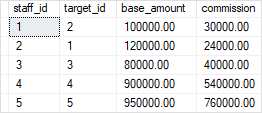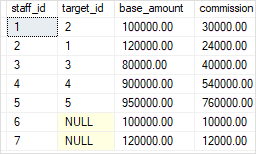Summary: in this tutorial, you will learn how to use the SQL Server UPDATE JOIN statement to perform a cross-table update.
SQL Server UPDATE JOIN syntax
To query data from related tables, you often use the join clauses, either inner join or left join. In SQL Server, you can use these join clauses in the UPDATE statement to perform a cross-table update.
The following illustrates the syntax of the UPDATE JOIN clause:
|
1
2
3
4
5
6
7
8
9
10
11
|
UPDATE
t1
SET
t1.c1 = t2.c2,
t2.c2 = expression,
...
FROM
t1
[INNER | LEFT] JOIN t2 ON join_predicate
WHERE
where_predicate;
|
In this syntax:
- First, specify the name of the table (t1) that you want to update in the
UPDATEclause. - Next, specify the new value for each column of the updated table.
- Then, again specify the table from which you want to update in the
FROMclause. - After that, use either
INNER JOINorLEFT JOINto join to another table (t2) using a join predicate specified after theONkeyword. - Finally, add an optional
WHEREclause to specify rows to be updated.
SQL Server UPDATE JOIN examples
Let’s take a look at some examples of using the UPDATE JOIN statement.
Setting up sample tables
First, create a new table named sales.targets to store the sales targets:
|
1
2
3
4
5
6
7
8
9
10
11
12
13
14
15
16
17
|
DROP TABLE IF EXISTS sales.targets;
CREATE TABLE sales.targets
(
target_id INT PRIMARY KEY,
percentage DECIMAL(4, 2)
NOT NULL DEFAULT 0
);
INSERT INTO
sales.targets(target_id, percentage)
VALUES
(1,0.2),
(2,0.3),
(3,0.5),
(4,0.6),
(5,0.8);
|
If sales staffs achieved the target 1, they will get the ratio of 0.2 or 20% sales commission and so on.
Second, create another table named sales.commissions to store the sales commissions:
|
1
2
3
4
5
6
7
8
9
10
11
12
13
14
15
16
17
18
19
20
21
22
|
CREATE TABLE sales.commissions
(
staff_id INT PRIMARY KEY,
target_id INT,
base_amount DECIMAL(10, 2)
NOT NULL DEFAULT 0,
commission DECIMAL(10, 2)
NOT NULL DEFAULT 0,
FOREIGN KEY(target_id)
REFERENCES sales.targets(target_id),
FOREIGN KEY(staff_id)
REFERENCES sales.staffs(staff_id),
);
INSERT INTO
sales.commissions(staff_id, base_amount, target_id)
VALUES
(1,100000,2),
(2,120000,1),
(3,80000,3),
(4,900000,4),
(5,950000,5);
|
The sales.commissions table stores sales staff identification, target_id, base_amount, and commission. This table links to the sales.targets table via the target_id column.
Our goal is to calculate the commissions of all sales staffs based on their sales targets.
A) SQL Server UPDATE INNER JOIN example
The following statement uses the UPDATE INNER JOIN to calculate the sales commission for all sales staffs:
|
1
2
3
4
5
6
7
8
9
|
UPDATE
sales.commissions
SET
sales.commissions.commission =
c.base_amount * t.percentage
FROM
sales.commissions c
INNER JOIN sales.targets t
ON c.target_id = t.target_id;
|
Here is the output:
|
1
|
(5 rows affected)
|
If you query the sales.commissions table again, you will see that the values in the commission column are updated:
|
1
2
3
4
|
SELECT
*
FROM
sales.commissions;
|

B) SQL Server UPDATE LEFT JOIN example
Suppose we have two more new sales staffs that have just joined and they don’t have any target yet:
|
1
2
3
4
5
|
INSERT INTO
sales.commissions(staff_id, base_amount, target_id)
VALUES
(6,100000,NULL),
(7,120000,NULL);
|
We assume that the commission for the new sales staffs is 0.1 or 10%, we can update the commission of all sales staffs using the UPDATE LEFT JOIN as follows:
|
1
2
3
4
5
6
7
8
9
|
UPDATE
sales.commissions
SET
sales.commissions.commission =
c.base_amount * COALESCE(t.percentage,0.1)
FROM
sales.commissions c
LEFT JOIN sales.targets t
ON c.target_id = t.target_id;
|
In this example, we used COALESCE() to return 0.1 if the percentage is NULL.
Note that if you use the UPDATE INNER JOIN clause, just the five rows of the table whose targets are not NULL will be updated.
Let’s examine the data in the sales.commissions table:
|
1
2
3
4
|
SELECT
*
FROM
sales.commissions;
|
The result set is as follows:

In this tutorial, you have learned how to use the SQL Server UPDATE JOIN statement to perform a cross-table update.